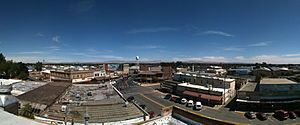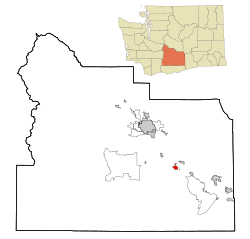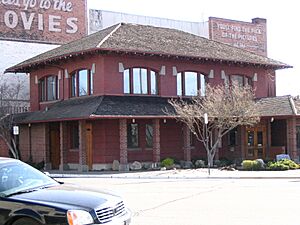Toppenish, Washington facts for kids
Quick facts for kids
Toppenish, Washington
|
|
|---|---|

Northward view over Toppenish in 2010
|
|

Location of Toppenish in Washington
|
|
| Country | United States |
| State | Washington |
| County | Yakima |
| Founded | 1884 |
| Incorporated | April 29, 1907 |
| Government | |
| • Type | Council–manager |
| Area | |
| • City | 2.17 sq mi (5.63 km2) |
| • Land | 2.17 sq mi (5.63 km2) |
| • Water | 0.00 sq mi (0.00 km2) |
| Elevation | 758 ft (231 m) |
| Population
(2020)
|
|
| • City | 8,854 |
| • Estimate
(2023)
|
8,650 |
| • Density | 3,980.81/sq mi (1,536.99/km2) |
| • Urban | 10,057 |
| • Metro | 256,643 (US: 193rd) |
| Time zone | UTC−8 (Pacific (PST)) |
| • Summer (DST) | UTC−7 (PDT) |
| ZIP Code |
98948
|
| Area code(s) | 509 |
| FIPS code | 53-71960 |
| GNIS feature ID | 1512732 |
Toppenish is a city in Yakima County, Washington, United States. In 2020, 8,854 people lived there. The city is located within the Yakama Indian Reservation, which was created in 1855.
Toppenish is known as the "City of Murals" because it has more than 75 murals painted on its buildings. The first mural, called "Clearing the Land," was painted in 1989. The city offers horse-drawn tours to see the murals and holds art events every year. All the murals show historically accurate scenes from the region between 1840 and 1940.
Contents
The History of Toppenish
Early Days and the Yakama Reservation
The land for the Yakama Indian Reservation was set aside by the Treaty of Washington in 1855. This land was owned by the entire Yakama tribe, not by individuals. The treaty was signed between the United States government, thirteen other Native American groups, and Chief Kamiakin. Through this treaty, the Yakama Nation gave up about 16,920 square miles (43,820 km2) of their original homeland. Before this, only Native Americans lived in the area.
For a while, the Yakama people lived mostly undisturbed. However, in 1883, a railroad was built into the area. This brought more white settlers who were looking for farmland. They joined ranchers who had already settled near the Columbia River.
The Dawes Act and Land Ownership
The Dawes Act of 1887 was a United States law. It was designed to make Native Americans adopt European-American ways of life. The act aimed to break up the shared tribal land on reservations. It gave parts of the land to individual Native American families. The goal was to encourage them to farm like European-Americans and understand private property.
Any land that the government decided was "extra" after these allotments could be sold to anyone. Many European Americans had been asking for more land in the West for years. Under certain rules, Native American landowners were also allowed to sell their plots.
Founding of Toppenish
Josephine Bowser Lillie was a Native American woman who received an 80-acre (320,000 m2) piece of land within the Yakama Reservation. She was part Native American and part European, and identified as Yakama. She is known as "The Mother of Toppenish." She divided the northern 40 acres (160,000 m2) of her land into smaller plots. These plots were the first pieces of land on the Yakama Nation Reservation that could be bought and sold individually.
William Leslie Shearer (1862–1922) was very important in the early growth of Toppenish. In 1897, Toppenish did not have a church. Shearer got permission from the Northern Pacific Railroad Company to use their freight room for religious services. After this, he helped start the first Methodist Church. He also helped build a new building that served as both a church and school classrooms. This building was ready for the 1898-1899 school year.
Later, Shearer left the railroad company. In 1905, he and his partner, Frank J. Lemon, opened Toppenish's first drugstore. About a year later, Shearer sold his share. He then focused on a new company called Yakima Produce and Trading. With partners George Plank, A.W. McDonald, and M. McDonald, they bought and leased land. They developed a 1,700-acre (6.9 km2) ranch near Satus Station. Shearer also built irrigation ditches to bring water from Satus Creek to the ranch.
Toppenish officially became a city on April 29, 1907. It was founded by Johnny Barnes. The city is still located within the boundaries of the Yakama Nation's Reservation.
What's in a Name? The Etymology of Toppenish
The name Toppenish likely comes from the Sahaptin language word Tẋápniš. This word means ‘protruded, stuck out’. It refers to a landslide that happened on a ridge south of White Swan, Washington. According to William Bright, a language expert, the name "Toppenish" comes from the Sahaptin word /txápniš/. This word describes a landslide, combining /txá-/, meaning "accidentally," and /-pni-/, meaning "to launch, to take forth and out."
Geography of Toppenish
Toppenish covers a total area of 2.17 square miles (5.63 km2). All of this area is land, with no water.
Population and People in Toppenish
| Historical population | |||
|---|---|---|---|
| Census | Pop. | %± | |
| 1910 | 1,598 | — | |
| 1920 | 3,120 | 95.2% | |
| 1930 | 2,774 | −11.1% | |
| 1940 | 3,683 | 32.8% | |
| 1950 | 5,265 | 43.0% | |
| 1960 | 5,667 | 7.6% | |
| 1970 | 5,744 | 1.4% | |
| 1980 | 6,517 | 13.5% | |
| 1990 | 7,419 | 13.8% | |
| 2000 | 8,946 | 20.6% | |
| 2010 | 8,949 | 0.0% | |
| 2020 | 8,854 | −1.1% | |
| 2023 (est.) | 8,650 | −3.3% | |
| U.S. Decennial Census 2020 Census |
|||
Toppenish Population in 2020
| Race / ethnicity (NH = non-Hispanic) | Pop. 2000 | Pop. 2010 | Pop. 2020 | % 2000 | % 2010 | % 2020 |
|---|---|---|---|---|---|---|
| White alone (NH) | 1,398 | 785 | 627 | 15.63% | 8.77% | 7.08% |
| Black or African American alone (NH) | 29 | 18 | 17 | 0.32% | 0.20% | 0.19% |
| Native American or Alaska Native alone (NH) | 594 | 627 | 580 | 6.64% | 7.01% | 6.55% |
| Asian alone (NH) | 22 | 13 | 15 | 0.25% | 0.15% | 0.17% |
| Pacific Islander alone (NH) | 1 | 0 | 7 | 0.01% | 0.00% | 0.08% |
| Other race alone (NH) | 13 | 26 | 21 | 0.15% | 0.29% | 0.24% |
| Mixed race or multiracial (NH) | 115 | 92 | 113 | 1.29% | 1.03% | 1.28% |
| Hispanic or Latino (any race) | 6,774 | 7,388 | 7,474 | 75.72% | 82.56% | 84.41% |
| Total | 8,946 | 8,949 | 8,854 | 100.00% | 100.00% | 100.00% |
In 2020, Toppenish had 8,854 people living in 2,397 households. About 1,926 of these were families. The population density was about 4,147 people per square mile (1,601 people/km2).
The city's population was made up of different groups. About 18.33% were White, 0.40% African American, and 9.36% Native American. About 0.36% were Asian, and 0.14% were Pacific Islander. A large part of the population, 84.41%, identified as Hispanic or Latino.
About 31.3% of residents were under 18 years old. About 9.3% were under 5 years old, and 11.9% were 65 or older. The population was 47.4% female.
Toppenish Population in 2010
In 2010, Toppenish had 8,949 people living in 2,237 households. About 1,900 of these were families. The population density was about 4,280 people per square mile (1,653 people/km2).
The racial makeup of the city was 33.85% White, 0.68% African American, and 8.05% Native American. About 82.56% of the population identified as Hispanic or Latino.
About 62.8% of households had children under 18. Many households (55.8%) were married couples living together. The average household had 3.96 people, and the average family had 4.22 people.
The average age in the city was 24.3 years. About 37.5% of residents were under 18. About 13.7% were between 18 and 24. The population was 51.3% male and 48.7% female.
Education in Toppenish
Public schools in Toppenish are managed by the Toppenish School District. Their main offices are located in the city.
The Yakama Nation Tribal School is also located next to Toppenish. This school is operated by the Yakama Nation.
Notable People from Toppenish
- Vicki Adams, a trick rider
- Fred Anderson, a former NFL player
- Leslie E. Brown, a United States Marine Corps aviator
- Bunky Echo-Hawk, a Native American artist and poet
- Terry Grosz, a game warden
- Charles Lollar, a businessman and political candidate
- A.B. Quintanilla, a record producer and musician
- Gregory Short, a composer, educator, and performer
- Dale E. Stovall, a United States Air Force general
- Billy J. Williams, a former United States attorney for the District of Oregon
See also
 In Spanish: Toppenish para niños
In Spanish: Toppenish para niños


